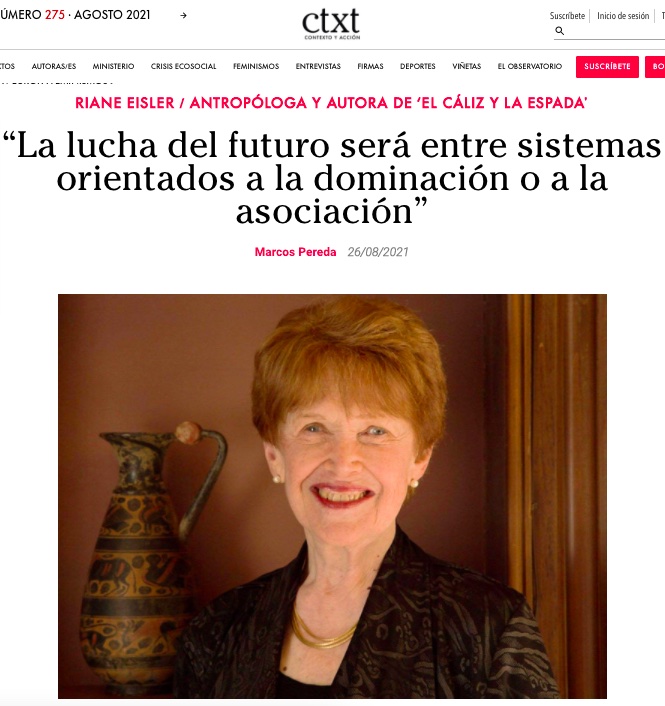September 7, 2021
Dr. Riane Eisler sat down for an interview with CTXT, an online independent Spanish publication, to discuss the Chalice and the Blade or el Cáliz y la Espada in Spanish.
The interview, conducted in Spanish by Marcos Pereda, covers a range of topics that Eisler has dedicated her life to studying.
Pereda begins by asking Eisler questions about matrilineality and matriarchy:
P: And, in your opinion, why is this matrilinearity lost?
E: Well, I think it was lost because the nearby cultures also changed a lot. Now we are moving into a more association-oriented space thanks to feminism, and we carry a lot of mental baggage. Somehow men (and some women) think that women are going to take control, but it's not about that, but about being partners.
The conversation moves onto Goddess imagery and ideas:
P: In our day there are still societies that are in the Neolithic (I am being deliberately simplistic, but I think we understand what I mean). Have these ideas about the Goddess been held there?
E: Well, some did. Look at the minangkabau (an ethnic group from Indonesia). Although they were conquered by the Muslims, they still worship the mountains, all with female names. And it is a matrilineal culture. There are more cases. But it is very clear that there was a change at a certain moment, and that appears perfectly reflected in the Art.
Violent scenes appear, with rulers (also gods) who are ten times larger than their subjects, people located in a lower space. They are no longer all standing at the same level and with the same size, as was the case when the Goddess was represented, but some have their arms raised in adoration. If we open our eyes we can see that the language is different, they are selling us a different way of seeing power, a different way of seeing women and men. We have to go investigating clues like Sherlock Holmes, shedding preconceived notions. We go back to the Bible. Women do a wonderful thing, which is to give life. But this act is considered dirty, since the woman who gives birth must later be purified by a male priest. It's crazy right? It does not make any sense. We talk about bringing a life to the world.
Pereda concludes the interview with a question about Eisler's most popular book:
P: One last question ... he published The Chalice and the Sword in 1987 ...
E: Yes, I wrote it in 1986, and on the occasion of the 30th anniversary I added a new epilogue ...
P: Do you think something has changed? Since the book appeared ...
E: I think so. What we mentioned earlier about hands, for example, is a symbol of something that has certainly changed. The evidence we have today that there were different cultures is very, very strong. In other words, archeology shows that our relationship to war is five or ten thousand years old, no more, and that is something to ponder. Anyway, Pinker still does not accept this, you know, there are people who are simply anchored in his vision. He clings to his idea that we are inherently warlike, we are inherently bad. Some get hooked on their old teachings. But there are changes.
Read the entire article in Spanish here.
How our peaceful society turned violent 5,000 years ago




[…] the Ten Forms of Capital, which applies regenerative principles to the economy. Another source is The Center for Partnership Systems, committed to supporting a ‘gylanic’ society that is based on equality of women and men, […]